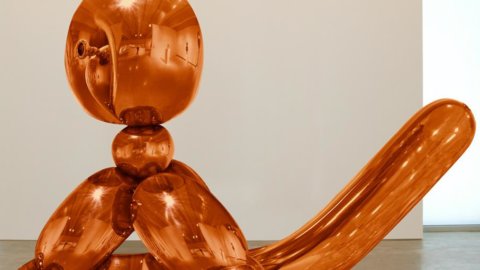Jeff Koons’ monumental stainless steel sculpture with its impressive scale, fluid line, and immaculate mirror-like surfaces, achieves a perfect tension between representation and abstraction. One year after Balloon Dog (Orange) set the world auction record for any living artist, Christie’s is honored to present the 20-foot-long Balloon Monkey (Orange) at the entrance of Christie’s 20 Rockefeller Plaza for six weeks, before being sold on November 12.
Seven years in the making, Balloon Monkey (Orange) marks a spectacular new chapter in Jeff Koons oeuvre. Looking at the miraculously smooth, highly polished surface of this monolithic balloon animal, one can appreciate how the artist has progressively attained ever-greater heights of perfection. He achieves this through careful planning, dogged determinism and an uncompromising commitment to his vision – outstripping even advanced industry in his technological ambition. Koons subjected the idea for this sculpture to years of research, modeling, computer rendering, milling, polishing, lacquering and polishing again before the final form was released to the public in all its glory. His perseverance has resulted in an incredibly seductive, monochrome finish that grants stainless steel and the humble balloon monkey an apotheosis. Part of its magic lies in the paradoxical interplays between lightness and weight, solidity and suggested transparency, and imposing permanence combined with transient reflections. The sheer beauty of its materiality is designed to ensnare and captivate, while its form is endowed with the joyful associations of childhood, hope, innocence, and its connection to art history and human history.
This is one of five unique Balloon Monkey sculptures made from precision engineered, mirror-polished stainless steel finished with a translucent brightly colored palette coating of either: blue, magenta, orange, red, or yellow. The sculpture extends the artist’s recurrent interest in air-filled forms, which stand as metaphors for the human condition. “I’ve always enjoyed objects that contain air because they are very anthropomorphic. Every time you take a breath, it’s like a symbol of life, and every time you exhale, it’s a symbol of death.” (Citation p. 5: Jeff Koons Versailles, cat. Expo., Paris, Editions Xavier Barral, 2008).
Since 1979, Koons worked with this idea of inflation and air when he developed his series,Inflatables. Koons has revisited this theme in myriad ways, including The New series (first exhibited in 1980), which integrated references to Minimalism and Pop with their encased vacuum cleaners and fluorescent tube lighting; Equilibrium (1985), best known for its bronze floatation devices and tanks with basketballs hovering in equilibrium; the Statuary series of stainless steel sculptures featuring his iconic Rabbit (1986); and the highly-acclaimed Celebration works, which represent the milestones of a calendar year, that he instigated in the early 1990s. It was inCelebration that the monumental twisted balloon sculptures made their first appearance, throughBalloon Dog. Koons has since moved on making three new animals, namely Balloon Swan (2004-11), Balloon Rabbit (2005-10) and the present work, Balloon Monkey (2006-13).
Because of its scale and simplified forms, it is easy to see Balloon Monkey (Orange) in almost architectural terms. The body is pyramidal, forming a strong base for the stacked spheres of head and neck, and the cantilevered tail. The subject has been reduced to its basic essence yet it remains easily identifiable as a monkey in repose, its jaunty tail hinting at the creature’s lively character. It is an abstraction that readily evokes Constantin Brancusi’s streamlined, polished forms or Picasso’s summarized animal sculptures made from repurposed household items. Koons’ subject has a slightly more complicated relationship with nature, however, for Balloon Monkey is in fact a flawless reproduction of an inanimate, real world object. That object just happens to be an abstraction of an organic form. Koons’ sculpture is then a kind of complicated simulacrum, a copy of a copy. It is an in-between ambiguous image that relates to both reality and illusion in a way that evokes the concern for the ‘signifier’ and the ‘signified’ frequently addressed in Pop art. For all that, the detail of Koons’ reproduced balloon animal is miraculous. The creases between the links and on the nose/knot are amazingly authentic – one can almost hear the squeaks of rubber that would have occurred when the original model was made.
Highly symbolic, the simplest of objects are for Koons a mystical metaphor of sexuality, immortality and man’s potential for transcendence. For the Chinese, monkeys are most closely associated with the literary epic Journey to the West – a tale widely known as Monkey in English-speaking countries. This sprawling Odyssey-like narrative is based on the pilgrimage of the Tang dynasty monk Xuanzang who traveled to India to obtain the sacred Buddhist texts that would help further the spread of this teaching in China. The Egyptians singled out baboons as particularly auspicious creatures, associating them with the god Thoth who stood for knowledge, science and magic. The ancient Greeks dispelled the monkey as an object of veneration, perhaps finding their unsettling combination of animal and human qualities at odds with their idealization of mankind. The first monkeys in Christian art are wicked creatures, more demon than animal, represented a falling away from perfection and God’s grace. In the Western art tradition, the monkey was eventually rehabilitated from its debased position via the humorous marginal designs known as drôleries that frequently appear in Gothic illuminated manuscripts. During the Renaissance the monkey-as-motif continued to progress from the sin-encumbered emblem of evil to positive comic rebel tasked with ridiculing the powers that be.
Our received wisdom tells us that polished metals represent wealth and spiritual enlightenment and Koons knowingly uses stainless steel as a tool of democratization for those values. An almost missionary zeal compels him and he often calls upon religious rhetoric to sanctify his aims. He has compared his work’s unashamed over-the-topness to lavishly decorated church interiors that communicate to the public that they are in the presence of the divine. The luster of Balloon Monkey (Orange) is similarly designed to manipulate its viewers and it has an immaculacy that verges on the spiritual. The sculpture’s gloriously warm hue may belong to the secular domain of art history, being originally inspired by Warhol’s revered Orange Marilyn of 1964, but it is also an important symbolic color to faiths across the world. Orange (or more precisely saffron) is the most sacred color in Hinduism and Buddhism, while in Confucianism, the religion and philosophy of ancient China, the color orange signified transformation. It is also a color typically associated with the sun and fire – surely the two most prototypical elements of worship.
The erotic is never far beneath the surface in Koons’ art and Balloon Monkey (Orange) continues this concept in a less overt fashion. Its smooth, glittering surface is highly sensual, eliciting touch, while its bulging form evokes comparison with the human body – not least in the animal’s tail, which undeniably resembles a phallic tumescence. Here, the monkey represents a positive agent of temptation. Its innocent, childish form invites us to experience pleasure without guilt, to embrace our sensuality.
The landmark exhibition at the Whitney Museum of America Art, ending October 19, is the most comprehensive survey ever devoted to the artist’s pioneering oeuvre and his first major museum retrospective in New York. The touring show will reopen again in November at the Centre Pompidou in Paris, where it will coincide with a display of works at the Musée du Louvre that will include examples of his Balloon Rabbit, Balloon Swan, and Balloon Monkey sculptures.





